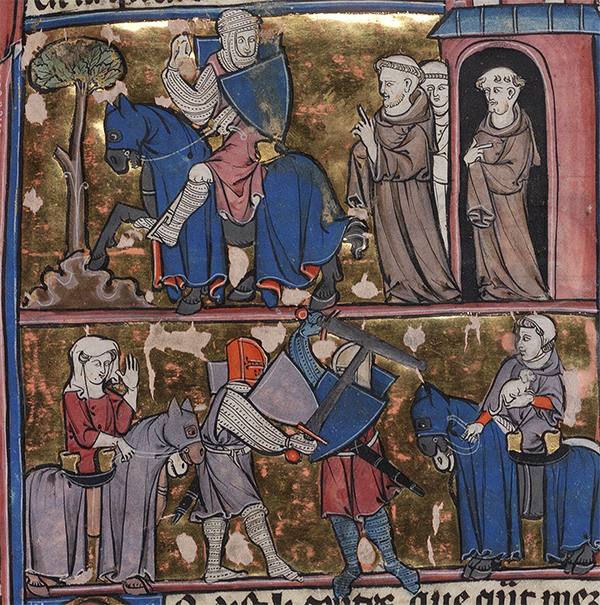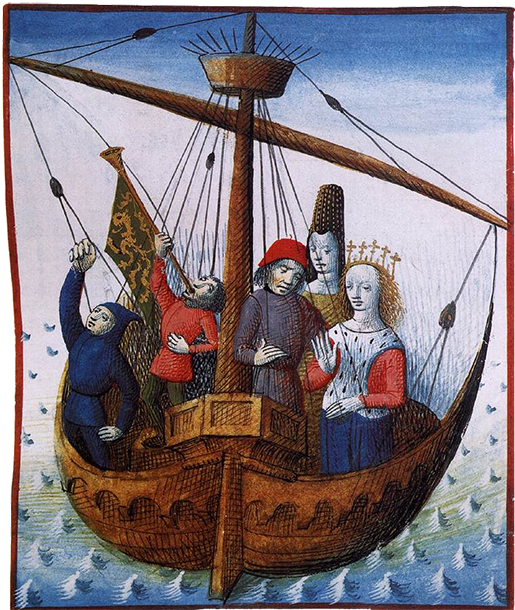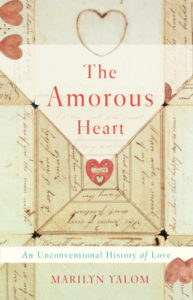
How Medieval Storytellers Shape Our Understanding of Romance
Matters of the Heart, from Arthurian Legend to Tristan and Isolde
The very word romance comes from the word roman—that is, a narrative written in one of the Romance languages derived from Latin (Italian, French, Spanish, Portuguese, Romanian). These tales often followed the adventures of a knight, whose aim was to prove himself in battle and in the bedroom. Over time the French word roman has come to stand for the genre of fiction known in English as the novel. Amorous love, in the Middle Ages and even today, was so bound up in the literature of love that it is difficult to know what came first: Did French medieval stories (romans) create the vision of love we now call romantic, or did romantic love exist prior to the storytellers?
Certainly the history of Abélard and Héloïse, from the first half of the 12th century, indicates that the troubadours were not the first medieval Europeans to obsess over passionate love. The story of the cleric Abélard’s seduction of his gifted pupil Héloïse, her pregnancy, their child named Astrolabe, their secret wedding, and Abélard’s subsequent castration at the hands of Héloïse’s vengeful uncle was already widespread during the couple’s lifetime.
It was common for medieval minstrels and storytellers to glorify the man or woman who gave his or her heart away at first sight or who had the good fortune of exchanging his or her heart with the beloved. Take, for example, the 12th-century poet Chrétien de Troyes (1130–1191) when he was under the patronage of Marie de Champagne, the daughter of Eleanor of Aquitaine and Louis VII of France. At Marie’s court in the bustling little city of Troyes, where love was elevated into an idealized code of conduct, Chrétien became Marie’s resident spokesman for the amorous heart.
 From a late 13th-century manuscript of the the Arthurian Romances (Beinecke Library, MS 229).
From a late 13th-century manuscript of the the Arthurian Romances (Beinecke Library, MS 229).
All five of Chrétien’s Arthurian romances make ample use of the word “heart” (cuer in Old French). References to the heart of his heroes, whether Cligès, Lancelot, Erec, Yvain, or Perceval, are frequent throughout their many fabulous adventures. More often than not their hearts are sad, suffering, regretful, and pained by their distance from the beloved. These negative sentiments lodged in the heart spurred the hero to action with the hope that by overcoming a perceived obstacle, the heart would ultimately find joy.
The heart extolled by 12th-century storytellers was always faithful to its one true love. As Chrétien de Troyes wrote in his masterful Lancelot, “Love, which rules / All hearts / allows them only / One home.” Similarly the chaplain Andreas Capellanus, who also enjoyed the patronage of Marie de Champagne, wrote in his Latin treatise On Love (De arte honeste amandi), “True love joins the hearts of two people with so great a feeling of love that they cannot long for the embraces of others.” Here and elsewhere Capellanus echoed some of the ideas already expressed by the Muslim philosopher Ibn Hazm a century earlier. Fidelity to the beloved was a given in medieval literature, whatever the truth might be outside the text in the lives of real people.
The belief in faithfulness applied whether the sought-after woman was a virginal maid or already married. Obviously, when the desired woman was someone else’s wife, love was, to say the least, problematic. The stories of Tristan and Isolde, Lancelot and Guinevere, and other adulterous couples spoke for the appeal of forbidden fruit. Though we can never know the extent to which adultery existed in real life, medieval society seems to have been obsessed with the subject of the adulteress, as reflected in numerous high-culture verse narratives and popular satirical tales known as fabliaux. Given the fear that women would produce bastard offspring, feudal practices made it difficult for them ever to be alone. Women of noble birth were constantly surrounded by other women—relatives and servants commanded by the male head of the house to keep careful watch over his wife or daughters.
“The heart extolled by 12th-century storytellers was always faithful to its one true love.”
One of the reasons for the popularity of adulterous stories lay in the belief, fashionable at the court of Marie de Champagne, that true love could not thrive within marriage. Indeed, when asked her opinion, she answered unequivocally, “We state and affirm unambiguously that love cannot extend its sway over a married couple.” She reasoned that lovers are free to grant or withhold their love, whereas married people are duty bound to satisfy each other and thus not susceptible to the spontaneous transports of lovers. Echoing his patroness, Capellanus at first defended the view that love can have no place between husband and wife. Yet by the end of On Love he had changed his mind. Reverting to a Christian stance, he claimed that the first rule (of 31) for lovers was, “Marriage does not constitute a proper excuse for not loving.” It is likely that Capellanus—a cleric—was ultimately uncomfortable with the negative stance on marital love taken by Marie de Champagne and others of her rank.
Though the French invented the form, the Germans quickly took to it. Consider Tristan and Isolde, whose story is best known to us today from the version written by Gottfried von Strassburg (circa 1180–1210) and, six centuries later, Wagner’s world-famous opera. In the course of adventures worthy of a superhero, Tristan proves himself to be a perfect knight, but when he is sent from Cornwall to Ireland to woo Isolde for his uncle, King Mark, his fate is sealed. On the return trip Tristan and Isolde mistakenly drink from a magic potion intended for Mark and Isolde on their wedding night. Henceforth, nothing can weaken the mutual passion that invades the bodies of Tristan and Isolde. Having consummated their love on the boat that brought them back to Cornwall, they will keep their erotic relationship hidden after Isolde is duly wed to Mark.
 From a 15th Century Tristan and Isolde manuscript (Musée Condé, Mss. 645-647).
From a 15th Century Tristan and Isolde manuscript (Musée Condé, Mss. 645-647).
One of the most famous scenes in the tale takes place in a grotto within a forest. It is a setting where sexual love reigns naturally among plants and animals, without the artificial constraints of society and religion. Lovemaking within this grotto is elevated to a form of devotion that unites body, heart, and spirit. To quote only a few lines from this paean to love: “They fed in their grotto on nothing but love and desire . . . pure devotion, love made sweet as balm that consoles body and sense so tenderly, and sustain the heart and spirit . . . they never considered any food but that from which heart drew desire, the eyes delight, and which body, too, found agreeable.”
Gottfried exalts eros and does not try to answer the moral questions raised by adultery. He places the heart at the center of the universe and assumes that it should direct human affairs, whatever the obstacles encountered. One modern critic, in commenting on Tristan, concluded that “everything is permitted for those who love.”
By 1200, in both French and German high culture, erotic love rivaled and even surpassed the value it had in Greek and Roman antiquity. Love might still be conceived of as madness, but a madness worth living and dying for. Tristan and Isolde will die for love; German even has a word for their act: liebestod (from liebe, meaning “love,” and tod, meaning “death”). Centuries later this tragic-cum-erotic destiny inspired Wagner’s glorious operatic version of Tristan and Isolde.
Medieval texts and images gave us men and women who were not so different in their heart of hearts. Like men, women had hearts that expanded to encompass love, that experienced desire and longing, and could be riddled with jealousy and despair. Despite the differences and inequalities that clearly existed between medieval men and women, the heart was considered a realm of equal opportunity.
__________________________________

From The Amorous Heart: An Unconventional History of Love. Used with permission of Basic Books. Copyright © 2018 by Marilyn Yalom.
Marilyn Yalom
Marilyn Yalom is a senior scholar at the Clayman Institute for Gender Research at Stanford University, and the author of A History of the Wife, among other books. She lives in Palo Alto, CA, with her husband, Irvin.



















